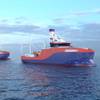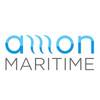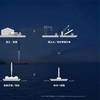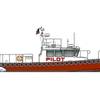The ATB : A History of the State-of-the-Art
The introduction of this type of vessel allows for the best of both worlds. A fully classed, dual-mode unit capable of operating in the pushing mode nearly 100% of the time, with a fully ocean-capable tug that is not a compromise design.. The barge and tug hulls are complimentary designs optimized for pushing, and able to take advantage of the fuel savings and speed advantages of controllable pitch propellers should the owner desire.
The ATB will obviously steer far better than a towed barge. However, steering performance is even better than deep-notch or other designs mating the tug to barge with fenders and backing wires. This is because the connection between tug and barge is made with a rigid, transverse axis. Steering then is positive, absolutely identical to that of a ship. There is no play in the cables or the fenders to throw off the autopilot on long voyages and emergency turning maneuvers are made instantly and at full power if required. This is also a great benefit when entering ports with tricky bar situations, where towed barges often wait long periods for seas to subside before entering or departing in what can be very heavy seas. Recent model tests run on our vessels, were designed to provide proof to Pacific Northwest pilots, that an ATB could effectively steer over the bars on the approaches to ports in that region, including the difficult Columbia River Bar. The model tests proved conclusively that in fact, the ATB could steer very effectively in both head and following seas, in departing bar situations.
The ATB requires less time and effort to both connect and disconnect on departure or arrival. There is no lost time and effort required to rig heavy backing wires or to work on the after-deck of the tug making up to a chain bridle. There is no necessity to go from towing gear to pushing gear when entering a harbor. This is not only a time consuming maneuver, it is also a dangerous one. All such operations are eliminated, saving as much as an hour inbound and outbound, not to mention reducing the risk of injury to crew members.
Pushing in a notch in a conventional manner creates major wear and tear on bow and side fenders on tugs, as well as creating damage to the notch side plating.. This expense is eliminated in the ATB, particularly in the Intercon-equipped units, because the only points of contact between tug and barge are the connecting helmets on each side of the tug. Also, tow wire replacement becomes infrequent due to the fact that the tug will push all the time. Also, in unmanned barges, bow damage will be greatly reduced because the tug will feel the slamming on the barge as opposed to feeling nothing while towing. Some Advantages of the ATB Over Towed Barges • Greatly reduced bow damage to barges, because the crew can feel pounding, unlike in towed barges. • Greatly reduced fender replacement (virtually none in 14 years) and tow wire replacement costs. • Elimination of back injury incidents by deck crew by not having to handle heavy towing gear. • More control over barge with a more powerful tug, reducing chances of groundings and dock damage because control of the vessel on approach is so vastly improved. • Ship-reliable ETA's. Improved scheduling capability. Higher average speeds. • Greater crew comfort at sea, as opposed to on the end of a towline. • 25% fuel saving vs. towing for the same speed, or a 25% increase in speed for the same fuel. • Ability to sail from port with predicted heavy weather, just as a ship would - unlike towed barges. • Reduced port time/elimination of transfer time from pushing to towing gear and back • Availability of a large, ocean tug for emergency and salvage work, and a means to deploy a spill boom in an accident, or essentially providing for the crew, a large, seperable seagoing lifeboat. • Full access to the barge at sea for emergency situations. • Individual units for insurance purposes - loss of one does not mean a unit CTL. • As compared to a ship, a wider availability of shipyard sites for drydocking the powerplant. • Ability to transit less congested "outside" routes as opposed to following protected routes. • Speed capability limited only by installed horsepower. • Increased safety when pushing by the elimination of backing wires that can part in emergency maneuvers. • Ability of both tug and barge to function as fully independent units when one or the other requires shipyarding.
It is important to note, from the view of this design office at least, that the ATB is not a "rule beater". The term implies that somehow the ATB gets around safety issues. Nothing could be further from the reality of the situation, when you talk of these large, ATB's. The gross tonnage advantages found in smaller units disappear, and the type of operation envisioned does not allow for skimping on the regulations. The true value of the ATB comes in being able to build it in specialized yards, where the tug yard can concentrate on the tug, and the barge yard on the barge - or both can be in one yard, under the overall design responsibility of the owner's architect. The key is design. This office has participated contractually in the design of over 25 operating ATB's. This experience spans over 22 years for me, and never once, have I ever found an owner for whom safety was not the top priority.
The ATB concept is also interesting from the standpoint of versatility. The barge can be anything, outfitted for almost any service. From a design standpoint this allows the use of the same propulsive system (tug) and same connection system (coupler and notch) and the same basic barge hull for a variety of different services, from liquid cargo, to bulk, to self-unloader, to containership. The extent to which this design benefit is of value to the owner, really does depend however, on whether or not there are significant differences in the configurations of these type barges, as each service has differing requirements for speed, dock limitations, turning basin limitations, air and water draft, pilotage, etc. Our experience is that while cookie-cutter designs are a great idea, like in ships, they only work in a very narrow field of application.
It is often noted and claimed that the only disadvantage to an ATB is its overall speed when compared to a typical ship of the same capacity. The ATB is indeed slower, but not to the point where the speed of the ship will give the ship any economic advantage especially in coastal trade or short trade routes (like trans-Gulf trade) where speed is not as critical as in actual transoceanic trade. And like most axioms, this is only true given similar installed horsepower for the two options. In general the ATB is capable of very good speeds, especially in the container and other light DWT capacity applications, where speeds upward of 14 - 15 knots are economically possible. ATB's are also regularly utilized by companies like K-Sea and Teco Shipping, in trans-oceanic service. Companies like Penn Maritime operate ATB's into Central and South America. Reinauer, Keystone, Bouchard, Sea River Maritime and others operate ATB's on long coastal voyages.
Another advantage often attributed to the ATB, which should be addressed, is the ability to "drop and swap". Drop and swap refers to the logistics possible in building multiple barges and utilizing a lesser number of tugs for moving the barges. (i.e. drop off an empty barge, turn the tug immediately, and pick up a loaded barge ) This has been looked at for some types of operations like fuel barges for power plants in remote regions, certain bulk trades, container shuttle services, etc. . Our firm had designed just such a system about to be built, which employs three tugs and six barges shuttling crude. One tug handles three barges - one loading - one discharging - one in transit. The third tug is a spare, needed because the barges truly are a pipeline which will be intolerant of downtime.
However, the advantages of this sort of system are available generally if the pick-up and drop locations are a distance apart that is conducive to closely matching load and discharge times to transit times; it is also a requirement that the pick up and rop off site be largely in protected waters. Despite advances in ATB technology, there is no connection system presently available which will allow you to reliably and safely pick up a barge offshore in a significant seaway and securely lock into it. The issue is however, being addressed, and the ability to leave the tug and barge safely connected during lightering type operations offshore has been proven with Maritrans' lightering operations in Delaware Bay.
Another consideration when discussing the connection system is size. Technologically speaking, according to manufacturers of these systems it is possible to build a coupling system for ATBs up to and possibly beyond the 500,000 bbl. size. Designs have been initiated for barges of up to 100,000LTDWT capacity, with tugs of 25,000 HP. However the largest pure ATB now in service is a 300,000 bbl. capacity unit, and it is utilizing a modified version of the standard Intercon system. However, our Voyager class tug, which is 155 feet long, is being created for three different owners with three different connection systems. This adaptability and flexibility is one of the reasons ATB's are so economical to build.
We are currently engaged in a number of international ATB projects, with contracts for vessel designs to operate in the Far East, South American, and South Pacific regions. This shows just how widely applicable this marine transport system is - and dispels the misconception that the ATB is a limited-use concept that is useful only in the States.
Pending ATB's for companies like Sause Bros., to an Elliott Bay design, and VMS, to their own design, are expanding the concept to the West Coast. ATB's by our firm and Bay Engineering, utilizing the Hydraconn Connection; and companies like Hannah Marine and McKeil, utilizing the hydraulic pad type systems, are making ATB's a reality on the Great Lakes. Acomarin's orders in various parts of the world, including western Canada, are also noteworthy.
In conclusion, the ATB has made its' mark on US coastal and ocean shipping. This "sorry-excuse-for-a-ship", is making believers out of former skeptics. The greatest compliment to a designer however, is not just the kudos from the management and executives of the companies that operate these units - it is also the way that the crews have embraced and accepted the ATB. It is the fact that the men and women who go to sea on these units are enthusiastic about their charges. We continue here to develop new applications for the ATB, and to refine the technology even further. As environmental forces apply pressure to reduce oil spills, the days of the large towed oil barge are certainly numbered. As scheduling of inventory in various product terminals tightens, the days when a customer could live with weather delays of the towed barge are past . The ATB is here to stay.
The author is the President of Ocean Tug & Barge Engineering Corp., a leading specialized designer of ATB units, and he is co-inventor of the proprietary Intercon connection system. His firm has had a hand in over half of the currently operating ATB's in the United States, and is currently involved in a number of design contracts for additional ATB's for both domestic and overseas customers. Mr. Hill has over 22 years experience in ATB design. His firm's website with additional information on ATB's, can be viewed at www.oceantugbarge.com.














